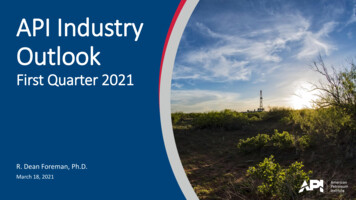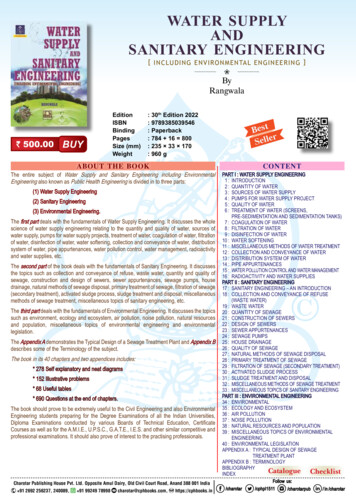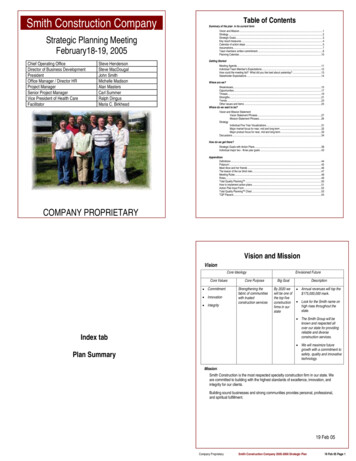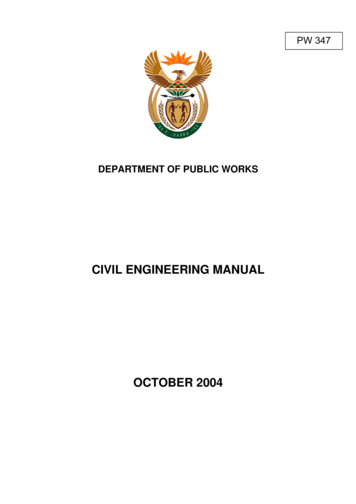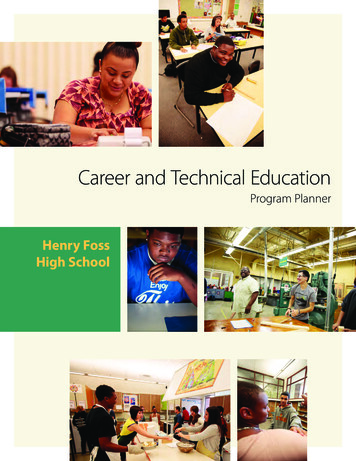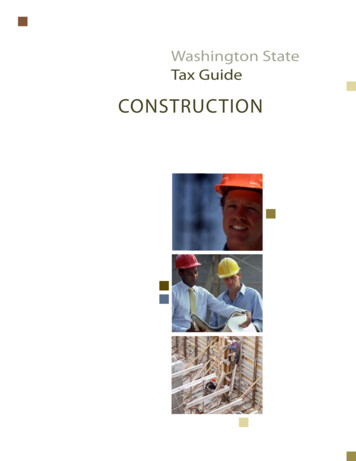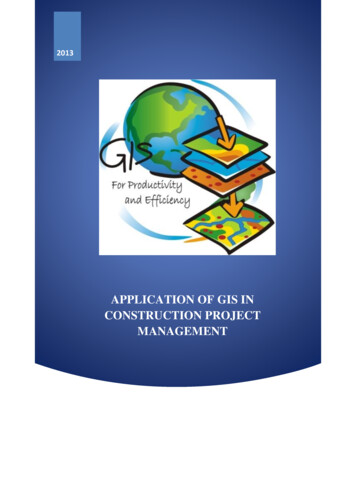
Transcription
n2021 engineering and constructionindustry outlook
2021 engineering and construction industry outlookE&C companies adapt to ongoingimpacts of the pandemicThe US engineering and construction (E&C) industrybegan 2020 on a bright note. The construction industryadded more than 900 billion to the US economy in thefirst quarter of 2020—the highest levels since the 2008recession.1 It employed 7.64 million people in February2020, also the highest levels since the 2008 recession.2Then, COVID-19 reached the US. The industry lost 60.9billion in GDP, and total jobs decreased to roughly 6.5million, effectively wiping out two years of GDP gains andfour years of job gains.3The E&C industry, however, had learned from the 2008recession and was well-positioned to weather thiseconomic shock. It had better control over its leverageand credit and had created a buffer through additionalcost savings. However, industry performance during therest of 2020 has been mixed. Some E&C companies weremore exposed to COVID-19–affected segments (like retailand hospitality), while others were not able to capitalizeon technology advancements. Most E&C companiescontinue to face sustained cost and margin pressures.Additionally, despite strong order books, companiesare experiencing challenges such as project delaysand cancellations and difficulty in obtaining permits. Inaddition, increases in procurement cost of materials andequipment continue to perplex many E&C companies.But there are reasons to be optimistic. Connectedtechnologies and an increase in associated investmentsmay help firms realize new operational efficiencies.New business models and an increase in M&A activityare further accelerating the shift toward digital andoperational efficiencies. Also, E&C companies are likelyto help other industries unlock the future of workplacesolutions.About the study : Deloitte postelection surveyTo understand the outlook and perspectives of organizations across the energy, resources, and industrials industries,Deloitte fielded a survey of more than 350 US executives and other senior leaders in November 2020 following the2020 US presidential election. The survey captured insights from respondents in five specific industry groups: chemicalsand specialty materials, engineering and construction, industrial products, oil and gas, and power and utilities.
2021 prospects1An uptick in public and commercial spendingcould improve the outlook for 2021In March, the pandemic made its presence felt across the E&C industry,causing the Associated Builders and Contractors’ Construction ConfidenceIndex (CCI) to plummet to 38.1.4 By June, however, the CCI rose to 51.1,indicating expansion in sales.5 The industry has also seen constructionspending gradually recovering from the sudden decline in the first half of2020.6 A Deloitte postelection poll (see “About the study”) found that 68%of the E&C executives surveyed characterize the business outlook for theirindustry as somewhat or very positive. Overall business performance in2020 can be described as uneven, depending on where an E&C firm sits inthe postpandemic economy.The housing segment is recovering on the back of low mortgage rates, andUS housing starts are expected to grow in 2021.7 On the homebuilders’front, extra credit buffers and conservative financial policies are likelyto keep confidence high.8 In contrast, the nonresidential segment newconstruction value is expected to register double-digit declines in 2020.9Apart from health care, public safety, and water infrastructure, spendingin other nonresidential segments either remained the same or declined.Lodging (including hotels and motels), manufacturing facilities andstructures, amusement and recreation, and office segments observed thebiggest spending declines in 2020 compared with 2019.10 Many companiesare also evaluating their future office space requirements as remote andwork-from-home models evolve, leading many commercial clients to eitherdelay or cancel their existing leases and contracts. This weakness is likely topersist well into 2021.11The different outlooks for residential and nonresidential segments canpresent various challenges for E&C companies in 2021. Smaller E&Cfirms with less balanced portfolios or a higher exposure to energy, travel,hospitality, or recreation end markets are likely to experience greatervolatility in the coming year. Larger E&C firms with more diversified exposuremay absorb this impact better. While the residential segment is expectedto recover through 2021, overall spending growth in 2021 will likely be ledby an uptick in public, infrastructure, and commercial building starts andrelated investments. In fact, in a Deloitte postelection poll, 70% of E&Cleaders agree that new infrastructure projects, if fully approved, can helpjump-start the economy.2021 engineering and construction industry outlook3
Margin disruption2Connected construction and modularization canaddress long-term costs and margin issuesThe E&C industry has been operating on razor-thin margins for many yearsnow, and the situation has only worsened since the pandemic outbreak.12 Inour 2020 outlook, we mentioned how the Turner Building Cost Index, whichmeasures US nonresidential building construction market cumulative costs(including labor rates and productivity, materials prices, and competitivemarketplace conditions) had reached a value of 1162, the highest levels inits 13-year history.13 The pandemic led the index to reach a new peak of1189 by the end of the first quarter of 2020.14 Since then, the index remainsnear the all-time high, likely driven by rising labor and material costs andsupply disruption as global supply chains continue to recover.15 A similarimpact can be seen on margins as well. The September Associated Buildersand Contractors survey shows that almost 77% of contractors surveyedindicate no change or a decline in profit margins, up about 10% from amonth earlier.16 Despite many E&C firms altering their cost structures, mostsuffered due to increasing material costs, contract extensions, and evenextended schedules leading to cost overruns.To reverse this situation, E&C companies should consider several ways tocreate long-term efficiencies and competitive advantage in 2021. One optionis to save costs via modularization and prefabrication design. Twenty-sixpercent of E&C executives in a Deloitte postelection poll indicate increasingtheir use of prefabrication and modular products. Module assembly yardsborrow some of the cost-efficiencies of manufacturing and could lead toconsiderable cost savings, ranging from 6% to 30%.17 Besides material costs,modularization and prefabrication can also help reduce labor costs, ensurebetter design and quality control, and shorten the project schedule toensure minimum budget overruns.And, although this is a longer-term potential payoff, E&C firms can alsoinvest and move toward advanced construction materials, such as durableor high-strength concrete, geosynthetics, geotextiles, fire-resistant timbers,and self-healing materials. Twenty percent of E&C executives in a Deloittepostelection poll indicate they are sourcing and using advanced materialsto address ongoing cost pressures. These may increase up-front costs, butcan likely help in later years to minimize and significantly reduce operatingand maintenance costs.18 This could become a key trend as the industryembraces more streamlined and connected approaches through the projectlife cycle, beyond Design-Build-Operate to better Own and Maintain as well(DBOOM).Another approach is to change the focus of technologyinvestments from isolated projects to integrated,enterprise-level initiatives. Firms should maketechnology investments that solve business-levelefficiency problems instead of stand-aloneproject-related issues. Through enterprise-scaletechnology investments, E&C companies can developa connected construction foundation—a dynamic,always-on network that provides continuous accessto information, analytics, and insights.19 Benefits areexpected to include as much as a potential 10% to 30%reduction in engineering hours, up to 10% reduction inbuild costs, and up to 20% reduction in operating costs,improving overall margins for E&C firms throughout theentire project life cycle.202021 engineering and construction industry outlook4
Digital differentiation3Digital investment can enable E&C firmsto differentiate themselves in 2021Digital is becoming the core enabler of future success in the constructionindustry. In a Deloitte postelection poll, 76% of E&C executives indicate thatthey are likely to invest in at least one digital technology in 2021. Digitalmoves business decisions from reactive to predictive and could enable E&Cfirms to outpace their competition. For this reason, it is likely to be a priorityon CIOs’ growth agendas in the coming year. Here are some specific areasand opportunities of digital initiatives that could enable E&C companies todifferentiate themselves: Technologies such as building information management (BIM) canhelp enhance real-time project visibility, eliminate cost overruns, andaccelerate the development timeline.21 Further applications of BIM intoofferings that incorporate energy efficiency and facilities management forcomprehensive lifecycle project management are also emerging.Digital supply networks can help to calibrate demand and supplyby ensuring constant material availability using machine learning andcognitive computing. This could help solve for a key challenge that 54%of contractors surveyed in a recent study indicate: the shortage of atleast one construction material.22Digital twin technologies can help make use of 3D data to generatebuilding profiles and blueprints of building parts and components in realtime, driving visibility and operational improvements across the buildinglife cycle.that these investments deliver value and returns.One approach is for E&C firms to identify ecosystempartners and connect with them to enable connectedconstruction together.24 This ecosystem approach canlikely be a key enabler for adjusting to new marketrealities, helping to better respond to disruptions.Autonomous rovers and drones can help conduct remote siteinspections.23 This can not only help improve worker safety, but alsoenhance productivity for inspection operations.After project delivery, predictive maintenance technologies canhelp E&C firms better manage assets and equipment. Preventing anyequipment downtime can increase efficiency and ensure on-timeproject delivery.Since some of the E&C industry seems to be lagging other industries indigital strategy and maturity, there is pressure to increase the pace of digitalinvestments. However, it is equally important for E&C companies to ensure2021 engineering and construction industry outlook5
M&A and alliances4The industry is likely to witness strongactivity in both traditional and nontraditionalpartnership approachesAs a learning from the 2008 recession, the E&C industry has beenincreasingly conscious of its capital allocations and cost structures. Theseefforts, combined with additional postoutbreak cost reduction efforts andstrong order books (1.3x book-to-build ratio based on 2019 data), haveensured enough cash and credit line buffers for companies to survive andcover liabilities in the short term. These spending cuts, however, also led toa 7x decline in 2020 M&A deal value when compared with 2019 ( 780 millionin the first three quarters of 2020 versus 5.89 billion during the first threequarters of 2019).25 The industry also avoided megadeals, with no dealsabove 500 million through the third quarter of 2020 compared with fourin 2019.26Interestingly, the number of deals announced remained the same duringthe first three quarters of 2020 compared with the same period in 2019.27This likely indicates that while the industry delayed making big commitments,it also kept its eye open to acquiring smaller and more specialized firms,including design, engineering, or technology companies; fabricated metalmanufacturers; and specialized contractors. During this period, E&Cand engineering, procurement, and construction (EPC) firms engaged indivestitures to gain specialization, increase margins, and decrease risk. In aDeloitte postelection poll, 28% of E&C executives surveyed believe the mainapproach for the industry will be increased M&A activity to help diversify thebusiness. Such moves are likely to accelerate in 2021 as companies launchtheir initiatives to diversify digital product portfolios and expand offerings inconnected services and advanced technologies.As we move into 2021, more E&C companies are also expected to targetdifferent business models (such as alliances to complement their expertise)and targeted consolidation. These alliances can likely also include E&Ccompanies embracing public-private partnerships (PPP) and making thempart of their network. More than 46% of E&C executives surveyed in aDeloitte postelection poll indicate that new public infrastructure workwill be a significant part of their business, and 14% are looking to formpublic-private partnerships to access these opportunities. The collectivecapabilities of partners may help companies better target the more than 1 trillion in US infrastructure upgrade spending anticipated in 2021.28Nontraditional M&A approaches, such as formingalliances with technology vendors via the developingecosystem,29 can help E&C companies gain accessto new capabilities and turnkey solutions faster andwithout the need for up-front investments.30 Targetedconsolidation in a fragmented and competitive US E&Cindustry is also likely to help enhance overall industrymargins and lead to the emergence of bigger E&Ccompanies.31 For example, between 2007 and 2020, thenumber of E&C companies on the Fortune 1000 list hasgrown by 45%.32Another trend to watch for in 2021 is more E&Ccompanies realigning their exposure to end markets viatargeted divestiture efforts. In a Deloitte postelectionpoll, 60% of E&C executives indicate plans to diversifytheir business to reduce exposure to underperformingsegments. From 2017–2020 year-to-date, 17% of alldeals in the industry were E&C companies divestingspecific business segments, likely exiting low-marginproduct segments and balancing exposure tounderperforming end markets. More recently, someof this activity may be related to reducing exposure tosegments affected by COVID-19, such as energy andtransportation.2021 engineering and construction industry outlook6
Future of work5E&C firms respond to new work,workforce, and workplace normsA rapid influx of digital technologies, ongoing labor shortages, COVID-19anxieties, and new workplace protocols present E&C firms with work,workforce, and workplace challenges as they head into 2021. In the wake ofthe pandemic’s arrival, the biggest question on the minds of E&C companieshas been how to restart work at job sites. The industry could not necessarilyreemploy the very same workforce, as some workers had been hired intoother positions, which made it challenging for some E&C companies toresume work. This was followed by workplace challenges of ensuring that jobsites had the required safety standards in place, which included restrictionsin the number of workers in an enclosed space and alterations in key job siteprocesses.33 Most E&C firms have absorbed these changes, but more workdisruption may await the E&C industry in 2021.In terms of workforce, the construction industry has been consistentlyadding new jobs and has recovered largely from the initial pandemic-drivenjob losses of early 2020. Despite this recovery, challenges due to talentshortages persist and are likely to be among the major themes for 2021.Bureau of Labor Statistics data suggests that since 2017, while the numberof job openings has almost doubled, the number of new hires has increasedby less than 10%.34This gap is due in part to the fact that the construction industry is likelyto incorporate more digital technologies into key work streams in orderto further enhance productivity, efficiency, and worker safety. Thesetechnologies include BIM and digital twins, which affect work from the designstage through material performance testing and remote project monitoringusing sensors and drones. In fact, 76% of E&C executives in a Deloittepostelection poll indicated they are investing in connected technologies toaddress broad cost and margin challenges, and 24% are investing in dronesand robotics at job sites to increase worker productivity and efficiency. Thesework changes make it important for E&C firms to start thinking of how rolesand jobs will change to reflect the use of these new technologies.The ongoing skills gap in the era of digitaltransformation can create a mismatch between theavailable employees and the necessary skills—as workincreasingly requires fluency with digital technologies.35This situation could negatively affect E&C firms invarious ways, including not being able to respondto market needs, losing project bids, and failing toinnovate. As E&C firms seek approaches to mitigatethese potential negative impacts, there are somepractices that will likely increase in the coming year.Engaging with an external talent ecosystem, developingin-house training programs, and training the futureworkforce are some of the long-term strategies thatmost E&C companies should consider adopting.2021 engineering and construction industry outlook7
2021 engineering and construction industry outlookPreparing today fortomorrow’s unknowns2020 was an unforgettable year in many ways and onethat may have permanently changed the world. The E&Cindustry was able to respond faster than other industriesdue to strong order books and demand from the residentialsegment. 2020 likely also helped E&C companies to resetand prepare sooner and better for work, workforce, andworkplace changes. The year ahead is only expected toaccelerate these changes. Connected construction presentsa host of efficiency- and productivity-enhancing technologiesand can enable new business models and strategies. Theremay be another disruptive event around the corner thatcould catch the world off guard. But those E&C firms thatadd to the lessons they’ve learned by embracing digital,forming strategic alliances, and preparing for the future ofwork will likely be better prepared for whatever comes next.
Let’s talkMichelle MeiselsPrincipalEngineering & Construction LeaderDeloitte Consulting LLPmmeisels@deloitte.com 1 213 688 3293Michelle is a principal in Deloitte Consulting LLP’s Technologypractice and leads the Engineering & Constructionpractice. Michelle focuses on large, often global, financeand information technology transformation programs byleveraging digital technology. She helps clients integratetechnologies with organizational and process standardpractices to achieve both qualitative and quantitative benefits.She specializes in cloud ERP, project controls, supply chainmanagement, and analytics technologies.2021 engineering and construction industry outlook9
Endnotes1.US Bureau of Economic Analysis, Construction Industry, “Value Addedby Industry, [Billions of dollars] Seasonally adjusted at annual rates,”accessed October 22, 2020.18.Engineering Materials, “Self-healing concrete could save 40bn inmaintenance costs,” November 3, 2015; Abir Al-Tabbaa, “The concretethat heals its own cracks,” World Economic Forum, January 20, 2016.2.US Bureau of Labor Statistics, Current Employment Statistics Highlights forConstruction Industry – September 2020, October 2, 2020, page 6.19.Michelle Meisels et al., “Winning with connected construction: Digitalopportunities in engineering and construction,” Deloitte, 2019.3.US Bureau of Economic Analysis, Construction Industry, “Value Addedby Industry, [Billions of dollars] Seasonally adjusted at annual rates”;US Bureau of Labor Statistics, Current Employment Statistics Highlights forConstruction Industry – September 2020.20.Deloitte, “Digital Capital Projects: The capital project of the future,” 2019.21.Michelle Meisels et al., “2020 engineering and construction outlook,”Deloitte, 2019.4.Associated Builders and Contractors, “Construction ContractorConfidence Plummets in Response to COVID-19, Says ABC,” April 23,2020, accessed October 22, 2020.22.Thaddeus Swanek, “New Study Shows Commercial Construction IndustryHas Guarded Optimism About Future,” US Chamber of Commerce,September 17, 2020.5.Associated Builders and Contractors, “ABC’s Construction BacklogSlips in September; Contractors Remain Optimistic,” October 13, 2020,accessed October 22, 2020.23.Michelle Meisels et al., “Winning with connected construction: Digitalopportunities in engineering and construction.”6.United States Census Bureau, “Monthly Construction Spending, August2020,” October 1, 2020, accessed October 22, 2020.24.Paul Wellener, Ben Dollar, et al., “Accelerating smart manufacturing: Thevalue of an ecosystem approach,” Deloitte Insights, October 21, 2020.7.Ibid.25.Deloitte analysis based on data from Thomson SDC Platinum.8.S&P Global Ratings, “U.S. Corporate Credit Outlook Midyear 2020 Homebuilders and Developers,” July 16, 2020, page 23.26.Ibid.27.Ibid.9.Engineering News-Record, “Starts Will Slowly Climb in 2021 After SharpDrop in 2020, Dodge Reports,” November 11, 2020.28.Deloitte analysis based on data and insights from Bloombergintelligence.10.Ibid.29.11.Associated Builders and Contractors, “ABC’s Construction Backlog Slipsin September; Contractors Remain Optimistic.”Paul Wellener, Ben Dollar, et al., “Accelerating smart manufacturing: Thevalue of an ecosystem approach,” Deloitte, October 21, 2020.30.12.Javier Parada, “Global Powers of Construction 2019,” Deloitte, July 2019.Deloitte, “M&A Trends Survey: The future of M&A deal trends in achanging world,” October 2020.13.Turner Construction, “Turner’s Third Quarter Building Cost Index:Construction Industry Continues To Feel Impact of the COVID-19Pandemic,” accessed November 2020.31.David Price, “The coming wave of consolidation for construction,” CNConstruction News, July 24, 2020.32.Fortune, “2020 US Fortune F1000 companies in Engineering &Construction,” accessed October 22, 2020; “2007 US Fortune F1000companies in Engineering & Construction,” accessed October 22, 2020.14.Ibid.15.American Bar Association, ”Dealing With The Construction Impacts OfCOVID-19,” March–June 2020.33.Engineering News-Record, “Pa. Gov Issues COVID-19 Safety Guidelinesas Crews Prepare to Resume Work,” April 24, 2020.16.Associated Builders and Contractors, “ABC’s Construction Backlog Slipsin September; Contractors Remain Optimistic.” October 13, 2020.34.17.Avi Friedman and Vince Cammalleri, “Cost Reduction ThroughPrefabrication: A Design Approach,” Taylor & Francis Group, June 9,2015; Georgia Pacific, “The power of prefab: controlling project qualityand cost,” 2019.US Bureau of Labor Statistics, “Construction Industry: WorkforceStatistics - Employment, Unemployment, and Openings, Hires, andSeparations,” accessed October 22, 2020.35.Paul Wellener, Ben Dollar, et al., “2018 Deloitte skills gap and future ofwork in manufacturing study,” Deloitte, 2018.2021 engineering and construction industry outlook10
About this publicationThis publication contains general information only and Deloitte is not, by means of thispublication, rendering accounting, business, financial, investment, legal, tax, or other professional advice or services. This publication is not a substitute for such professional adviceor services, nor should it be used as a basis for any decision or action that may affect yourbusiness. Before making any decision or taking any action that may affect your business, youshould consult a qualified professional adviser. Deloitte shall not be responsible for any losssustained by any person who relies on this publication.About the Deloitte Research Center for Energy & IndustrialsDeloitte’s Research Center for Energy & Industrials combines rigorous research withindustry-specific knowledge and practice-led experience to deliver compelling insights thatcan drive business impact. The Energy, Resources, and Industrials industry is the nexus forbuilding, powering, and securing the smart, connected world of tomorrow. To excel, leadersneed actionable insights on the latest technologies and trends shaping the future. Throughcurated research delivered through a variety of mediums, we uncover the opportunities thatcan help businesses move ahead of their peers.About DeloitteDeloitte refers to one or more of Deloitte Touche Tohmatsu Limited, a UK private companylimited by guarantee (“DTTL”), its network of member firms, and their related entities. DTTLand each of its member firms are legally separate and independent entities. DTTL (alsoreferred to as “Deloitte Global”) does not provide services to clients. In the United States,Deloitte refers to one or more of the US member firms of DTTL, their related entities thatoperate using the “Deloitte” name in the United States, and their respective affiliates. Certainservices may not be available to attest clients under the rules and regulations of publicaccounting. Please see www.deloitte.com/about to learn more about our global network ofmember firms.Copyright 2020 Deloitte Development LLC. All rights reserved.
2021 engineering and construction industry outlook 3 An uptick in public and commercial spending could improve the outlook for 2021 In March, the pandemic made its presence felt across the E&C industry, causing the Associated Builders and Contractors’ Construction Confidence Index (CCI) to



